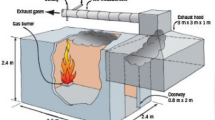Abstract
Waste bags from nuclear facilities filled with plastic personal protective equipment were tested to measure their fire hazard. Heat release rate (HRR), smoke yield and incident heat flux from waste bag fires were measured in a room/corner test apparatus. Three different size bags were tested in the corner of the room in order to check the effect of waste bag size. Full size waste bags were tested in the three different locations: in the center, in the corner and against the back wall of the room in order to check the effect of location. Bag fires can produce high HRRs (~800 kW) indicating that special caution is needed for waste bag management in nuclear facilities. Different size bags burn in a similar manner which allows a simple analytical tool to be developed to estimate transient HRR. In addition to the analytical tool, smoke yield and heat flux data can be used to simulate the waste bag fires and to validate fire model simulations.





















Similar content being viewed by others
References
Nowlen SP (1986) Heat and mass release for some transient fuel source fires: a test report. Sandia National Laboratories, Albuquerque.
Volkingburg DRV, Williamson RB, Fisher FL, Hasegawa H (1978) Towards a standard ignition source. Lawrence Berkeley Laboratory, Berkeley.
Ahonen A, Kokkala M, Weckman H (1984) Burning characteristics of potential ignition sources of room fires. Valtion Teknillinen Tutkimuskeskus, Espoo.
Babrauskas V, Krasny JF (1985) Fire behavior of upholstered furniture. National Bureau of Standards, Gaithersburg.
Lee BT (1985) Heat release rate characteristics of some combustible fuel sources in nuclear power plants. National Bureau of Standards, Gaithersburg.
Stroup DW, Madrzykowski D (2003) Heat release rate tests of plastic trash container. National Institute of Standards and Technology, Gaithersburg.
Mehaffey JR, Craft ST, Richardson LR, Batista M Fire experiments in furnished houses. In: 4th International symposium on fire and explosion hazards Northern Ireland 2004. FireSERT, University of Ulster, pp 163–174.
Nowlen SP (1987) Quantitative data on fire behavior of combustible materials found in nuclear power plants: a literature review. Sandia National Laboratory, Albuquerque.
EPRI/NRC (2010) Supplement 1 fire probabilistic risk assessment methods enhancements. EPRI U.S. NRC, Palo Alto.
Babrauskas V (2002) Heat release rate. In: DiNenno PJ, Drysdale D, Beyler CL, Walton WD (eds) The SFPE handbook of fire protection engineering 3rd edn. National Fire Protection Association, Quincy.
ASTM (2012) Standard guide for room fire experiments. ASTM E603 vol E603. ASTM, West Conshohocken.
ASTM (2011) Standard test method for heat and visible smoke heat release rates for materials and products using oxygen depletion ASTM E1354 vol E1354. ASTM, West Conshohocken.
The California Technical Bulletin 133: flammability test procedure for seating furniture for use in public occupancies (1991). North Highlands, California.
Mulholland GW (2008) Smoke production and properties. In: DiNenno PJ (ed) The SFPE handbook of fire protection engineering, National Fire Protection Association, Quincy.
Wolin SD, Ryder NL, Leprince F, Milke JA, Mowrer FW, Torero JL (2001) Measurements of smoke characteristics in HVAC ducts. Fire Technol 37(4):363–395. doi:10.1023/A:1012776916407.
Cummings WM (1998) Smoke movement analyses. M.S. Thesis, Worcester Polytechnic Institute.
Mulholland GW, Croakrin C (2000) Specific extinction coefficient of flame generated smoke. Fire Mater 24:227–230.
ASTM (2011) Standard test method for measuring heat transfer rate using a thin-skin calorimeter. ASTM E459 vol E459. ASTM, West Conshohocken.
Alston J (2004) Room/corner fire calibration data: Marine composite screening specimens. M.S thesis, Worcester Polytechnic Institute.
De Ris J, Khan M (2000) A sample holder for determining material properties. Fire Mater 24:219–226.
Drysdale D (1998) An introduction to fire dynamics, 2nd edn. Wiley, Chichester.
Taylor BN, Kuyatt CE (1994) Guidelines for evaluating and expressing the uncertainty of NIST measurement results. NIST, Gaithersburg.
Babrauskas V, Peacock RD (1992) Heat release rate: the single most important variable in fire hazard. Fire Saf J 18:255–272.
Alpert RL (2008) Ceiling jet flows. In: DiNenno PJ (ed) The SFPE handbook of fire protection engineering, 4th edn. National Fire Protection Association, Quincy.
Bwalya A (2008) An overview of design fires for building compartments. Fire Technol 44(2):167–184. doi:10.1007/s10694-007-0031-7
NFPA (2013) National fire alarm code and signaling code. NFPA 72 NFPA, Quincy.
NFPA (2012) Standard for smoke control systems. NFPA 92 NFPA, Quincy.
Butler KM, Mulholland GW (2004) Generation and transport of smoke components. Fire Technol 40(2):149–176. doi:10.1023/B:FIRE.0000016841.07530.64
Acknowledgments
The authors greatly appreciate the support for this work by Savannah River Nuclear Solutions, LLC (AC818440) and Department of Energy (DE-AC09-08SR470). Many thanks go to Randall Harris at WPI for conducting the room tests.
Author information
Authors and Affiliations
Corresponding author
Rights and permissions
About this article
Cite this article
You, YG., Park, H., Dembsey, N.A. et al. Characteristics of Nuclear Facility Waste Bag Fires. Fire Technol 51, 129–152 (2015). https://doi.org/10.1007/s10694-013-0368-z
Received:
Accepted:
Published:
Issue Date:
DOI: https://doi.org/10.1007/s10694-013-0368-z




